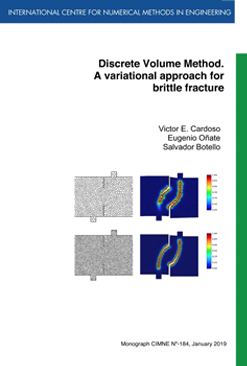Discrete Volume Method. A variational approach for brittle fracture
FREE!
Editorial: CIMNE
Year of publication: 2019
Pages: 120
Editorial: CIMNE
Year of publication: 2019
Pages: 120
Description
The Discrete Element Method has been used to simulate fracture dynamics
beacuse its inherent capacity to reproduce multi-body interaction, but
in the case of elasticity mechanics the microparameters of the numerical
model, required to replicate the properties of the material, are difficult to
calibrate. On the other hand, damage models based on finite element
strategies can easily reproduce the properties of the media but they can
not simulate the dynamics of multiple fractures.
We propose a numerical approach, the Discrete Volume Method, to
simulate fracture of brittle materials without the disadvantages mentioned,
by combining the benefits of variational formulations and the numerical
convenience of discrete element method to capture the dynamics of cracks.
The Discrete Volume Method does not have microparameters, since the
displacements are computed using the material properties and the fracture
mechanism is controlled by an auxiliary damage field.
Within this thesis we discuss a numerical strategy to solve the elasticity
problem upon unstructured and non conforming meshes, allowing all kinds
of flat-faced elements (polygons in 2D and polyhedra in 3D). The core of
the formulation relies on two numerical procedures the Control Volume
Function Approximation (CVFA), and the polynomial interpolation in the
neighborhood of the control volumes, which is used to solve the surface
integrals resulting from applying the divergence theorem. By comparing
the estimated stress against the analytical stress field of the well known
test of an infinite plate with a hole, we show that this conservative approach
is robust and accurate. A similar strategy is used to get the damage field
solution.
In order to coupling both fields, displacement and damage, we use a
finite increment arrangement for reducing the resdidual of elastic equation
within each time step.
We develop a numerical formulation for time discretization based on
the analytical solution of the differential equation resulting from assuming
a continuous variation of internal forces of the system between time steps.
Finally, we show the effectiveness of the methodology by performing
numerical experiments and comparing the solutions with published results.
Additional information
| format | Monograph |
|---|---|
| Year of Publication | 2019 |

